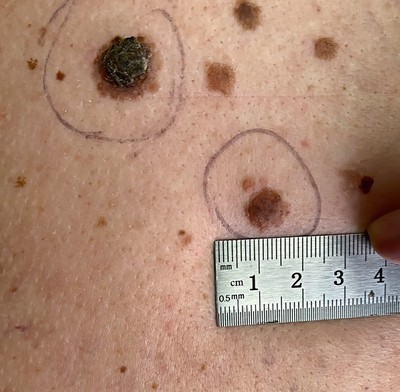Melanoma Facts and Warning Signs
May is Skin Cancer Awareness Month and melanoma is the deadliest form of skin cancer. You may ask yourself, what is melanoma? Melanoma is a cancerous growth that originates in a particular type of skin cell known as the melanocyte. It can appear anywhere on your skin, including underneath a nail or even the bottom of a foot. People who tend to be in the “high risk” category include those with light skin, light eyes, red hair, and anyone who has a greater tendency to burn when exposed to the sun. In addition, it is more prevalent if you have a positive family history of melanoma. Although people with these specific qualities have a higher risk, melanoma can affect anyone, regardless of race or skin color. It is important to be educated about melanoma because it is malignant. It can spread to other parts of the body and can cause death.

How to identify Melanoma
Melanoma can be hard to identify if you don’t know what you are looking for. Most skin care professionals recommend looking for the “ugly duckling,” the mole that stands out compared to the others on your skin. One trick to help you is the ABCDEs of melanoma. “A” is for asymmetry. Any mole that is asymmetrical, one side not looking like the other, can be suspicious. “B” stands for border. The border of a normal mole should appear in a regular pattern around the whole lesion. Comparatively, an irregular border may have a “notched” appearance. “C” is for color. The color of an atypical looking mole can have different variations of brown, black, tan, red, or blue. “D” is for diameter. Anything bigger than a pencil eraser (>6 mm) should be evaluated. Lastly, “E” stands for evolution, which includes the changing of size, shape, or color. In addition to the ABCDEs of melanoma, if you have a mole that starts to itch, bleed, or hurt, it is strongly advised to seek medical attention. These are more warning signs that warrant a skin biopsy to be performed by a dermatologist, a certified physician assistant or nurse practitioner.
A skin biopsy is used to diagnose melanoma. If a biopsy report is positive for melanoma, your provider can discuss the treatment plan, which can be different for each case. Depending on the stage of melanoma, treatment may consist of multiple factors, including surgical excision, lymph node removal, radiation, chemotherapy, and immunotherapy.
Where melanoma comes from
One thing that people may or may not know is that melanoma does not just come from sun damage or UV ray exposure (commonly found in tanning booths). Melanoma can originate in areas that are hidden from the sun, specifically in moles that transform into a cancerous growth. Therefore, it is important to be familiar with your skin, enabling you to easily identify any new moles that have appeared. Melanoma can also form from a “sun spot” in someone with many years of previous sun exposure / UV damage. For this reason, dermatologists encourage everyone to utilize sun protection (SPF of at least 30, wear a hat, seek shade), even on days when the sun is not visible. Another tip is performing self-skin exams once per month. This involves looking over your skin for any new or suspicious looking lesions that could possibly be or turn into melanoma. It is imperative to know the ABCDEs of melanoma and the “ugly duckling” sign. Don’t forget to check under your nails and the bottoms of your feet!
When in doubt, check it out
If you or a loved one notice a spot that looks suspicious on your skin, please do not hesitate to make an appointment with a dermatologist, certified physician assistant, or nurse practitioner so that it can be evaluated properly. These medical professionals use a dermatoscope. We often tell patients it is like a fancy magnifying glass. This helps us look for certain patterns of a lesion that may lead to a skin biopsy. Lastly, it is encouraged to be seen by a dermatology specialist at least once a year for a full body skin exam (a skin cancer screening). It is important to have someone with the proper tools and knowledge evaluate your skin. Don’t be afraid to urge your loved ones to get checked. This simple act helps raise awareness about melanoma!
One in five Americans will develop skin cancer in their lifetime. Schedule an annual skin exam at your nearest Schweiger Dermatology Group clinic. Call 844-DERM-DOC.
